A Low-Cost Vision-Based Monitoring of Computer Numerical Control (CNC) Machine Tools for Small and Medium-Sized Enterprises (SMEs)
Abstract
1. Introduction
Monitoring of Machine Tool Status
2. Vision-based Monitoring of Machine Tools
2.1. Monitoring Using a Webcam and Optical Character Recognition (OCR)
2.2. Identifying the Operating Status of Machine Tools
3. KEM Monitoring System
3.1. KEM Client
- ROI manager: To analyze characters, ROIs of target items, based on the captured image, need to be defined, including locations (x and y), size (width and height), type (numeric or string), and a parameter for image processing. To support intuitive and easy-to-use of registering ROIs, a Graphical User Interface (GUI) with buttons and a list view of ROIs was designed. To specify the required input parameters, the user can capture an image from the video stream of the connected webcam and adjust a threshold value for pre-processing of the captured image. For enhancing the user experience, upper and lower boundaries of ROI also can be specified in this capturing process. A name of operational data is selected in a list menu, and the data type is set based on the predefined conditions, as shown in Table 2, automatically. Then, ROI manager converts subsets of the captured image by pre-processing, cropping, and image modifications, and transfers them to the OCR engine. All ROI information can be saved in a data file, and the file can be loaded for the same monitoring condition in future use.
- OCR engine: The OCR engine analyze subsets of a captured image using the OCR algorithm, the Google Tesseract. Results of the OCR process were converted based on the ROI data. Because of the imperfections of the OCR process, some abnormal values of the results are replaced as the previous one. This approach is a naive solution, but effective because most abnormal values would not be expected to change significantly within the sample period because of the dynamic properties of mechanical components, such as inertia and friction, in manufacturing equipment.
3.2. KEM Server
- Communication and data platform: To support standardized communication and data gathering from various smart sensors in IoT networks, Mobius platform is used as a data platform of the KEM server. Mobius is an IoT server platform complying with the oneM2M standards [61]. It provides all of the functionalities for IoT devices, including registration, data management and repository, device management, security, communication management and delivery handling, discovery, subscription, and notification. For interconnecting the Mobius and end-point devices, such as smart sensors, the Mobius provides bindings for MQTT using a wireless network. In the Mobius platform, Node.js and MySQL are used as a core development framework and Database Management System (DMBS) as a data storage, respectively.
- Data processing: In the monitoring of machine tools, the operational data can be treated as events that occurred either at a point in time or over a range of time. Using event processing technologies can support to detect particular patterns of higher-level abstract events, as well as simple events, and react to them in a real-time manner. With the increasing use of computing devices and network communications, techniques, such as Rule Engine (RE) and Complex Event Processing (CEP) have been investigated comprehensively over the last decades [62,63]. In this study, an automation module that includes RE and CEP is developed using the Python language for data analytics. These two sub-processes can be used to identify simple and complex events by the rule like IFTTT (IF This, Then That) or pattern matching using sliding time windows. For example, when an event occur, means the machine tool status is changed or goes over a specific limitation, the KEM server can react to send an alarm message to the users through SMS or email automatically. For managing events, Node-RED is used. Node-RED is one of the flow-based programming tools, developed by IBM, and widely used for integrating information flows of IoT devices [64].
- Data visualization: An online monitoring application via web pages is developed for data visualization. The advantages of web-based tools are not only familiar user interface, but also good accessibility to the resources and knowledge [65]. The users can access the monitored operating data through a web browser on their laptop or mobile phone. To display the data in a graphical form, such as chart and gauge, Node-RED Dashboard is used. Node-RED Dashboard is a front-end visualization tool for the Node-RED.
4. Implementation and Evaluations
5. Conclusions and Future Works
Author Contributions
Funding
Conflicts of Interest
References
- Shab, K. The Fourth Industrial Revolution: What It Means, How to Respond; World Economic Forum: Cologny, Switzerland, 2016. [Google Scholar]
- Morris, H.D.; Simon, E.; Jill, F.; Kimberly, K.; Marcus, T. A Software Platform for Operational Technology Innovation; IDC: Framingham, MA, USA, 2014; pp. 1–17. [Google Scholar]
- Burke, R.; Adam, M.; Stephen, L.; Martin, H.; Brenna, S. The smart factory: Responsive, adaptive, connected manufacturing. Deloitte Insights 2017, 31, 1–10. [Google Scholar]
- Liu, C.; Xun, X. Cyber-physical machine tool—The era of machine tool 4.0. Procedia CIRP 2017, 63. [Google Scholar] [CrossRef]
- Kim, D.H.; Kim, T.J.Y.; Wang, X.; Kim, M.; Quan, Y.-J.; Oh, J.W.; Min, S.-H.; Kim, H.; Bhandari, B.; Ahn, S.H.; et al. Smart Machining Process Using Machine Learning: A Review and Perspective on Machining Industry. Int. J. Precis. Eng. Manuf. Green Technol. 2018, 5, 555–568. [Google Scholar] [CrossRef]
- Lee, J.H.; Noh, S.D.; Kim, H.-J.; Kang, Y.-S. Implementation of cyber-physical production systems for quality prediction and operation control in metal casting. Sensors 2018, 18, 1428. [Google Scholar] [CrossRef] [PubMed]
- Herrmann, C.; Christopher, S.; Denis, K.; Stefan, B.; Sebastian, T. Sustainability in manufacturing and factories of the future. Int. J. Precis. Eng. Manuf. Green Technol. 2014, 1, 283–292. [Google Scholar] [CrossRef]
- Beier, G.; Silke, N.; Tilla, Z.; Bing, X. Sustainability aspects of a digitalized industry—A comparative study from China and Germany. Int. J. Precis. Eng. Manuf. Green Technol. 2017, 4, 227–234. [Google Scholar] [CrossRef]
- Büttner, K.-H.; Brück, U. Use case industrie 4.0-fertigung im siemens elektronikwerk amberg. In Handbuch Industrie 4.0; Springer: Berlin/Heidelberg, Germany, 2017; pp. 45–70. [Google Scholar]
- Strähle, J.; Grünewald, A.K. The prosumer concept in fashion retail: Potentials and limitations. In Green Fashion Retail; Springer: Singapore, 2017; pp. 95–117. [Google Scholar]
- European Parliament. Industry 4.0. In Policy Department A: Economic and Scientific Policy; European Parliament: Brussels, Belgium, 2016. [Google Scholar]
- Moeuf, A.; Pellerin, R.; Lamouri, S.; Giraldo, S.T.; Barbaray, R. The industrial management of SMEs in the era of Industry 4.0. Int. J. Prod. Res. 2018, 56, 1118–1136. [Google Scholar] [CrossRef]
- Kumari, S.; Singh, A.; Mishra, N.; Reyes, J.R.G. A multi-agent architecture for outsourcing SMEs manufacturing supply chain. Robot. Comput. Integr. Manuf. 2015, 36, 36–44. [Google Scholar] [CrossRef]
- Mulyono, N.B.; Ishida, Y. Development of manufacturing support system for SME under disruption risk. Procedia Comput. Sci. 2013, 22, 753–761. [Google Scholar] [CrossRef][Green Version]
- Levy, M.; Powell, P. Strategies for Growth in SMEs: The Role of Information and Information Sytems; Butterworth-Heinemann: Oxford, UK, 2004. [Google Scholar]
- Wang, C.; Walker, E.; Redmond, J. Explaining the lack of strategic planning in SMEs: The importance of owner motivation. Int. J. Organ. Behav. 2007, 12, 1–16. [Google Scholar]
- Müller, J.M.; Buliga, O.; Voigt, K.-I. Fortune favors the prepared: How SMEs approach business model innovations in Industry 4.0. Technol. Forecast. Soc. Chang. 2018, 132, 2–17. [Google Scholar] [CrossRef]
- Singh, R.K.; Garg, S.K.; Deshmukh, S.G. Strategy development by SMEs for competitiveness: A review. Benchmarking Int. J. 2008, 15, 525–547. [Google Scholar] [CrossRef]
- Moeuf, A.; Tamayo, S.; Lamouri, S.; Pellerin, R.; Lelievre, A. Strengths and weaknesses of small and medium sized enterprises regarding the implementation of lean manufacturing. IFAC PapersOnLine 2016, 49, 71–76. [Google Scholar] [CrossRef]
- Kagermann, H.; Helbig, J.; Hellinger, A.; Wahlster, W. Recommendations for Implementing the Strategic Initiative INDUSTRIE 4.0: Securing the Future of German Manufacturing Industry; Final Report of the Industrie 4.0 Working Group; Acatech: Munich, Germany, 2013. [Google Scholar]
- Laasch, O.; Conaway, R. Principles of Responsible Management: Global Sustainability, Responsibility, and Ethics; Cengage Learning: New York, NY, USA, 2014. [Google Scholar]
- OECD. Enterprises by Business Size (Indicator). Available online: https://data.oecd.org/entrepreneur/enterprises-by-business-size.htm (accessed on 3 September 2018).
- Gaughran, W.F.; Burke, S.; Phelan, P. Intelligent manufacturing and environmental sustainability. Robot. Comput. Integr. Manuf. 2007, 23, 704–711. [Google Scholar] [CrossRef]
- Park, H.; Qi, B.; Dang, D.-V.; Park, D.Y. Development of smart machining system for optimizing feedrates to minimize machining time. J. Comput. Des. Eng. 2018, 5, 299–304. [Google Scholar] [CrossRef]
- Ardanza, A.; Moreno, A.; Segura, Á.; Cruz, M.; Aguinaga, D. Sustainable and flexible industrial human machine interfaces to support adaptable applications in the Industry 4.0 paradigm. Int. J. Prod. Res. 2019, 57, 4045–4059. [Google Scholar] [CrossRef]
- Zhong, R.Y.; Wang, L.; Xu, X. An IoT-enabled real-time machine status monitoring approach for cloud manufacturing. Procedia CIRP 2017, 63, 709–714. [Google Scholar] [CrossRef]
- Smith, G.T. CNC Machining Technology: Volume 3: Part Programming Techniques; Springer Science & Business Media: Berlin, Germany, 2013. [Google Scholar]
- Goindi, G.S.; Sarkar, P. Dry machining: A step towards sustainable machining—Challenges and future directions. J. Clean. Prod. 2017, 165, 1557–1571. [Google Scholar] [CrossRef]
- Vijayaraghavan, A.; Dornfeld, D. Automated energy monitoring of machine tools. CIRP Ann. 2010, 59, 21–24. [Google Scholar] [CrossRef]
- Teti, R.; Jemielniak, K.; O’Donnell, G.; Dornfeld, D. Advanced monitoring of machining operations. CIRP Ann. 2010, 59, 717–739. [Google Scholar] [CrossRef]
- Stavropoulos, P.; Chantzis, D.; Doukas, D.; Papacharalampopoulos, A.; Chryssolouris, G. Monitoring and control of manufacturing processes: A review. Procedia CIRP 2013, 8, 421–425. [Google Scholar] [CrossRef]
- Wang, W.H.; Hong, G.S.; Wong, Y.S.; Zhu, K.P. Sensor fusion for online tool condition monitoring in milling. Int. J. Prod. Res. 2007, 45, 5095–5116. [Google Scholar] [CrossRef]
- Tapoglou, N.; Mehnen, J.; Vlachou, A.; Doukas, M.; Milas, N.; Mourtzis, D. Cloud-based platform for optimal machining parameter selection based on function blocks and real-time monitoring. J. Manuf. Sci. Eng. 2015, 137. [Google Scholar] [CrossRef]
- Mourtzis, D.; Vlachou, E.; Xanthopoulos, N.; Givehchi, M.; Wang, L. Cloud-based adaptive process planning considering availability and capabilities of machine tools. J. Manuf. Syst. 2016, 39, 1–8. [Google Scholar] [CrossRef]
- Mori, M.; Fujishima, M. Remote monitoring and maintenance system for CNC machine tools. Procedia CIRP 2013, 12, 7–12. [Google Scholar] [CrossRef]
- Campos, J.G.; Miguez, L.R. Standard process monitoring and traceability programming in collaborative CAD/CAM/CNC manufacturing scenarios. Comput. Ind. 2011, 62, 311–322. [Google Scholar] [CrossRef]
- Mano, L.Y.; Faiçal, B.S.; Nakamura, L.H.V.; Gomes, P.H.; Libralon, G.L.; Meneguete, R.I.; Filho, G.P.R.; Giancristofaro, G.T.; Pessin, G.; Ueyama, J.; et al. Exploiting IoT technologies for enhancing Health Smart Homes through patient identification and emotion recognition. Comput. Commun. 2016, 89, 178–190. [Google Scholar] [CrossRef]
- Borges PV, K.; Izquierdo, E. A probabilistic approach for vision-based fire detection in videos. IEEE Trans. Circuits Syst. Video Technol. 2010, 20, 721–731. [Google Scholar] [CrossRef]
- Poh, M.-Z.; McDuff, D.J.; Picard, R.W. Non-contact, automated cardiac pulse measurements using video imaging and blind source separation. Opt. Express 2010, 18, 10762–10774. [Google Scholar] [CrossRef]
- Siranee, N.; Michael, C.R.; Joshua, P. Three hundred and sixty degree real-time monitoring of 3-D printing using computer analysis of two camera views. J. Manuf. Mater. Process. 2017, 1, 2. [Google Scholar]
- Kurada, S.; Bradley, C. A review of machine vision sensors for tool condition monitoring. Comput. Ind. 1997, 34, 55–72. [Google Scholar] [CrossRef]
- Lee, D.J.; Kim, S.H.; Ahn, J.H. Breakage detection of small-diameter tap using vision system in high-speed tapping machine with open architecture controller. KSME Int. J. 2004, 18. [Google Scholar] [CrossRef]
- Zelinski, P. How cameras improve capacity. Mod. Mach. Shop 2011, 83, 88–90. [Google Scholar]
- Ahmad, M.M.; Cuenca, R.P. Critical success factors for ERP implementation in SMEs. Robot. Comput. Integr. Manuf. 2013, 29. [Google Scholar] [CrossRef]
- Krasner, H. Ensuring e-business success by learning from ERP failures. IT Prof. 2000, 2. [Google Scholar] [CrossRef]
- Gallaher, M.P.; Oliver, Z.T.; Rieth, K.T.; O’Connor, A.C. Economic Analysis of Technology Infrastructure Needs for Advanced Manufacturing: Smart Manufacturing. Int. Natl. Inst. Stand. Technol. 2016. [Google Scholar] [CrossRef]
- Wang, L.; Shen, W.; Orban, P.; Lang, S. Remote monitoring and control in a distributed manufacturing environment. In Condition Monitoring and Control for Intelligent Manufacturing; Wang, L., Gao, R.X., Eds.; Springer: London, UK, 2006; pp. 289–313. [Google Scholar]
- Waurzyniak, P. Electronic intelligence in manufacturing. Manuf. Eng. 2001, 127, 44. [Google Scholar]
- Denkena, B.; Harms, A.; Jacobsen, J.; Möhring, H.C.; Lange, D.; Noske, H. Life-cycle oriented development of machine tools. In Proceedings of the 13th Cooperative Institutional Research Program International Conference on Life Cycle Engineering, Leuven, Belguim, 30 May–2 June 2006. [Google Scholar]
- Espí-Beltrán, J.V.; Virgilio, G.-I.; Fernández, D.R. Enabling distributed manufacturing resources through SOA: The REST approach. Robot. Comput. Integr. Manuf. 2017, 46. [Google Scholar] [CrossRef]
- Syafrudin, M.; Alfian, G.; Fitriyani, N.L.; Rhee, J. Performance analysis of IoT-based sensor, big data processing, and machine learning model for real-time monitoring system in automotive manufacturing. Sensors 2018, 18, 2946. [Google Scholar] [CrossRef]
- Pritoni, M.; Auslander, D.M. Operating systems for small/medium commercial buildings. In Intelligent Building Control Systems: A Survey of Modern Building Control and Sensing Strategies; Wen, J.T., Mishra, S., Eds.; Springer International Publishing: Cham, Switzerland, 2018; pp. 45–69. [Google Scholar]
- Froiz-Míguez, I.; Fernández-Caramés, T.M.; Fraga-Lamas, P.; Castedo, L. Design, implementation and practical evaluation of an IoT home automation system for fog computing applications based on MQTT and ZigBee-wifi sensor nodes. Sensors 2018, 18, 2660. [Google Scholar] [CrossRef]
- Lynn, R.; Wescoat, E.; Han, D.; Kurfess, T. Embedded fog computing for high-frequency MTConnect data analytics. Manuf. Lett. 2018, 15, 135–138. [Google Scholar] [CrossRef]
- Laurindo, Q.; Gonçalves, M.; Peixoto, T.A.; Rangel, J.A. Communication mechanism of the discrete event simulation and the mechanical project softwares for manufacturing systems. J. Comput. Des. Eng. 2018. [Google Scholar] [CrossRef]
- Akasiadis, C.; Pitsilis, V.; Spyropoulos, C.D. A multi-protocol IoT platform based on open-source frameworks. Sensors 2019, 19, 4217. [Google Scholar] [CrossRef] [PubMed]
- Brecher, C.; Jasper, D.; Fey, M. Analysis of new, energy-efficient hydraulic unit for machine tools. Int. J. Precis. Eng. Manuf. Green Technol. 2017, 4, 5–11. [Google Scholar] [CrossRef]
- Park, J. Evaluating a mobile data-collection system for production information in SMEs. Comput. Ind. 2015, 68, 53–64. [Google Scholar] [CrossRef]
- Smith, R. An overview of the tesseract OCR engine. In Proceedings of the Ninth International Conference on Document Analysis and Recognition (ICDAR 2007), Parana, Brazil, 23–26 September 2007. [Google Scholar]
- Han, X.; Wang, Z.; He, Y.; Zhao, Y.; Chen, Z.; Zhou, D. A mission reliability-driven manufacturing system health state evaluation method based on fusion of operational data. Sensors 2019, 19, 442. [Google Scholar] [CrossRef]
- Yun, J.; Ahn, I.-Y.; Choi, S.-C.; Kim, J. TTEO (Things Talk to Each Other): Programming smart spaces based on IoT systems. Sensors 2016, 16, 467. [Google Scholar] [CrossRef]
- Qin, Y.; Sheng, Q.Z.; Falkner, N.J.G.; Dustdar, S.; Wang, H.; Vasilakos, A.V. When things matter: A survey on data-centric internet of things. J. Netw. Comput. Appl. 2016, 64. [Google Scholar] [CrossRef]
- Paschke, A.; Kozlenkov, A. Rule-Based Event Processing and Reaction Rules; Springer: Berlin/Heidelberg, Germany, 2009. [Google Scholar]
- Blackstock, M.; Lea, R. Toward a distributed data flow platform for the web of things (distributed node-red). In Proceedings of the 5th International Workshop on Web of Things, Cambridge, MA, USA, 9 October 2014; pp. 34–39. [Google Scholar]
- Kim, H.; Chu, W.-S.; Ahn, S.-H.; Kim, D.-S.; Jun, C.-S. Web-based design and manufacturing systems for micromachining: Comparison of architecture and usability. Comput. Appl. Eng. Educ. 2006, 14. [Google Scholar] [CrossRef]
- Malek, Y.; Kharbouch, N.A.; Khoukhi, H.E.; Bakhouya, M.; Florio, V.D.; Ouadghiri, D.E.; Latre, S.; Blondia, C. On the use of IoT and big data technologies for real-time monitoring and data processing. Procedia Comput. Sci. 2017, 113. [Google Scholar] [CrossRef]
- Bonomi, F.; Milito, R.; Zhu, J.; Addepalli, S. Fog computing and its role in the internet of things. In Proceedings of the First Edition of the MCC Workshop on Mobile Cloud Computing, Helsinki, Finland, 17 August 2012; pp. 13–16. [Google Scholar]


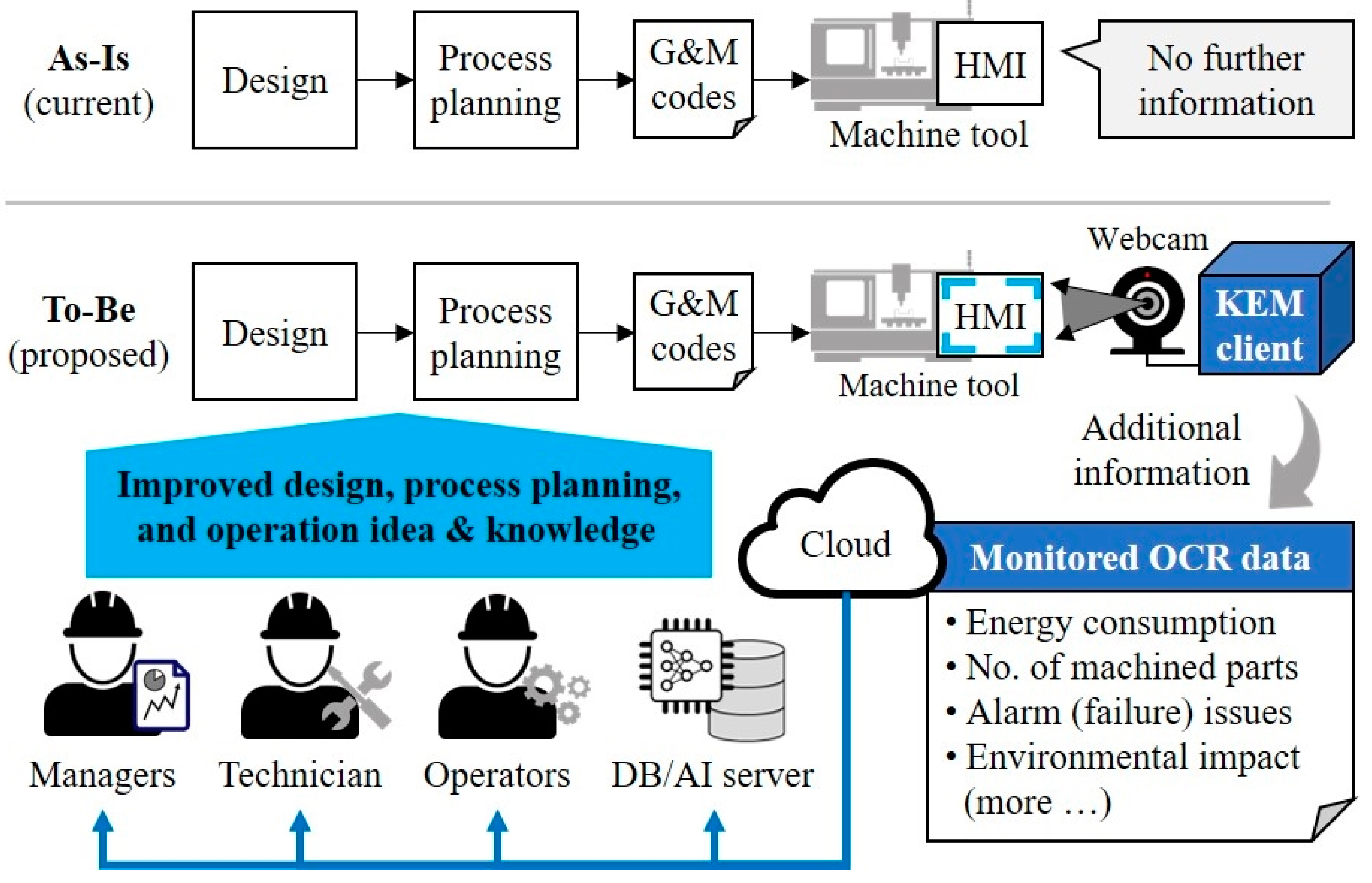
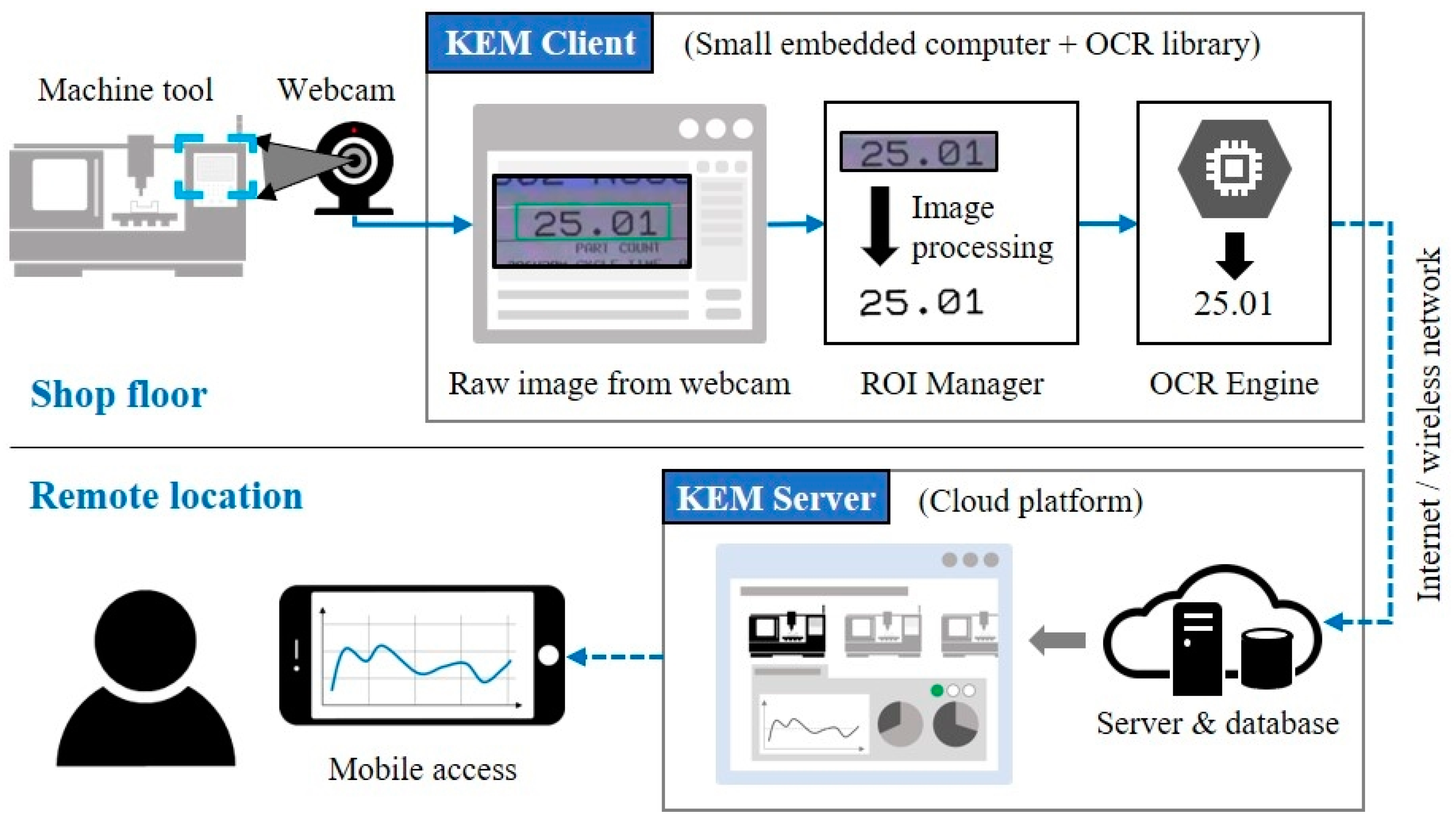
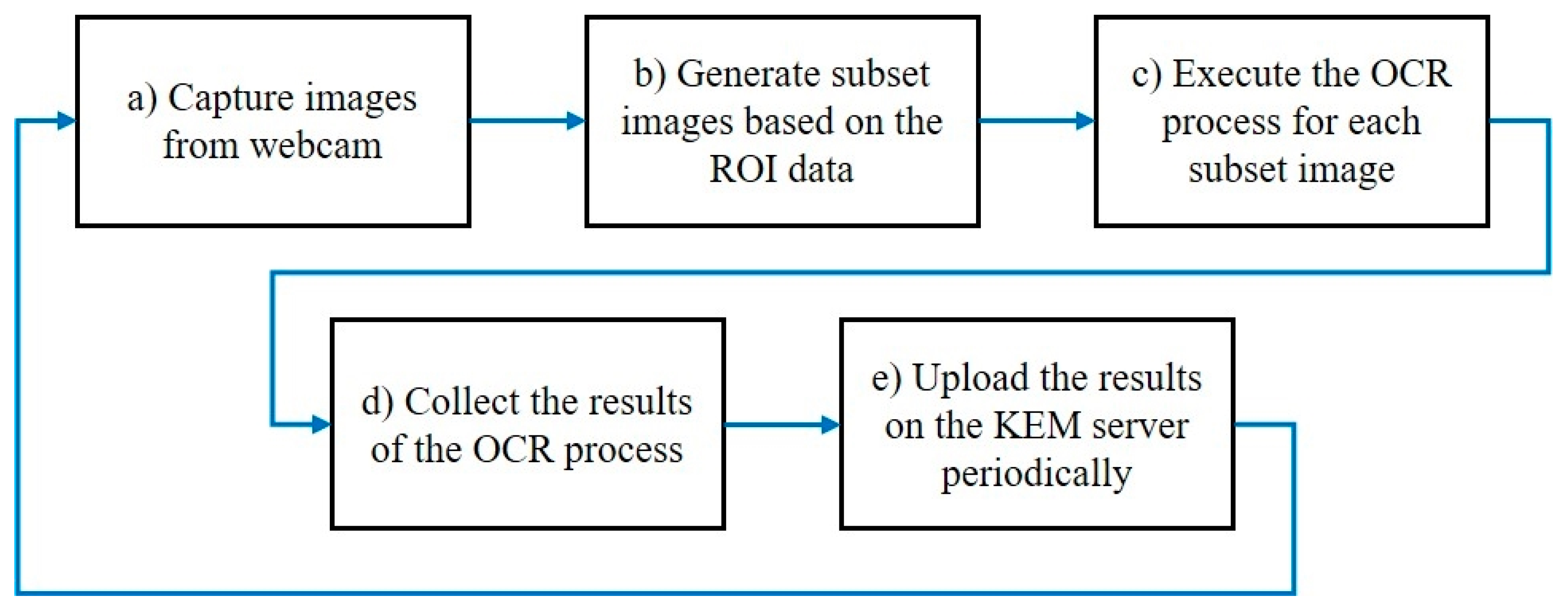
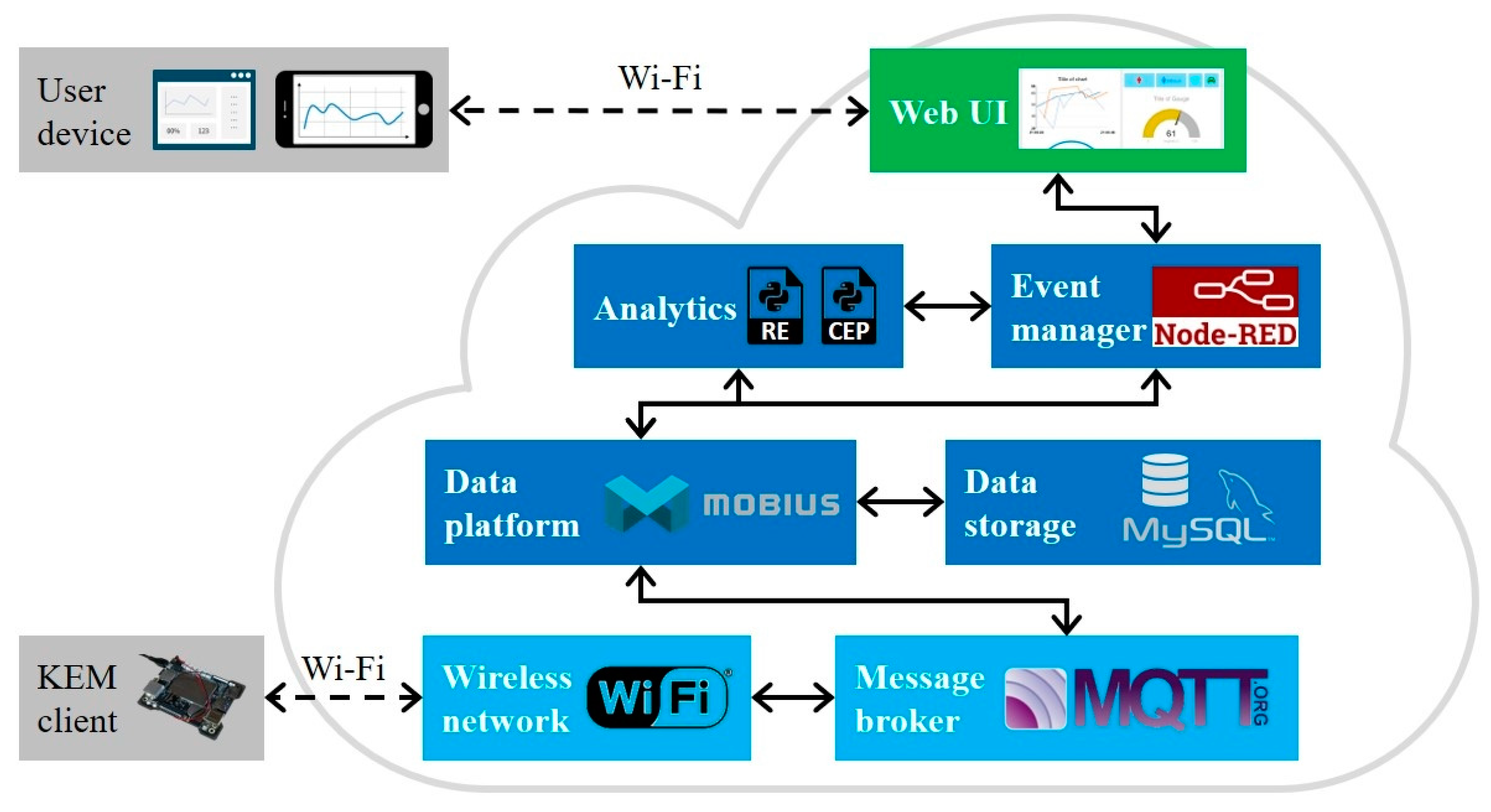

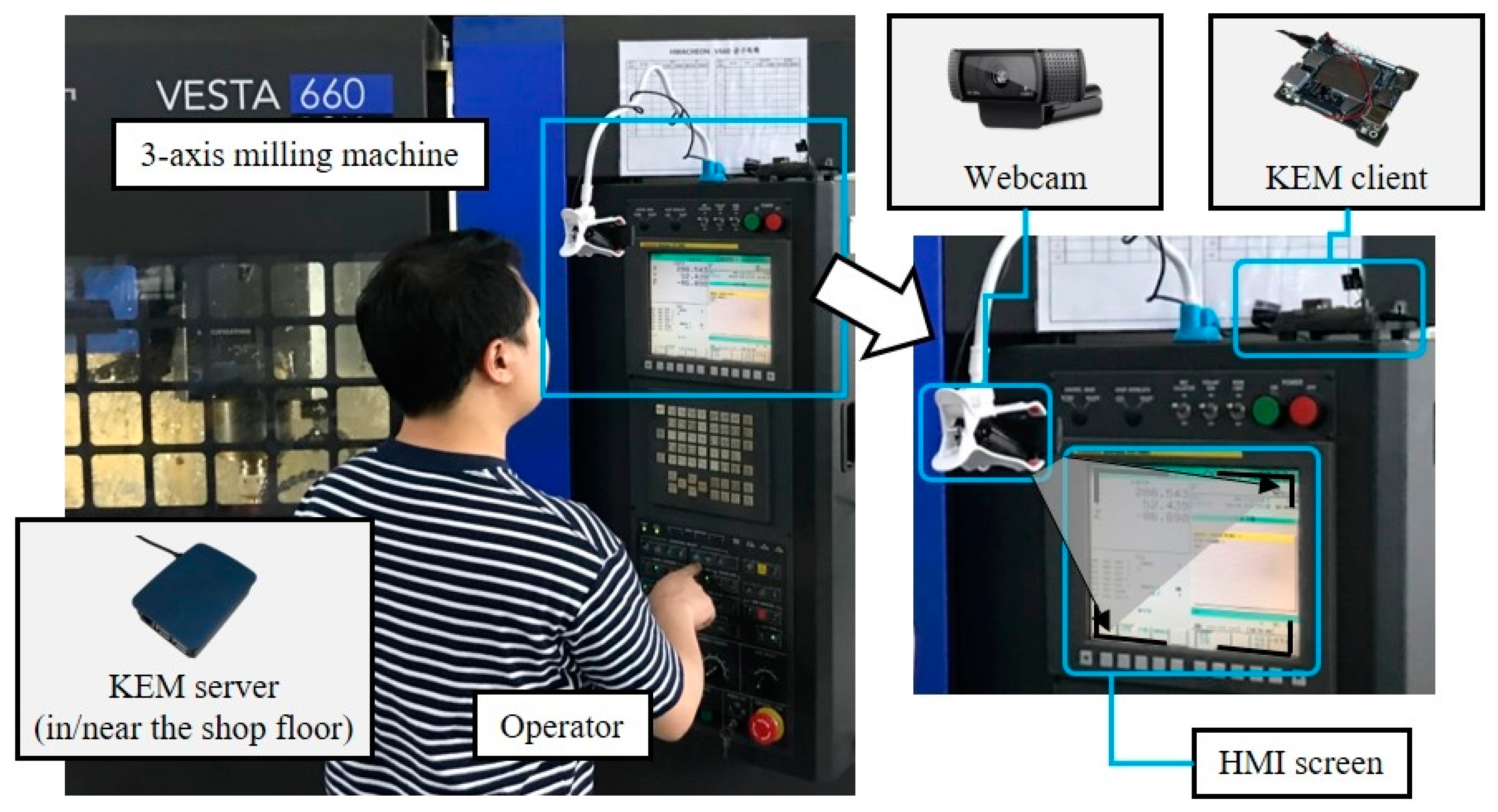
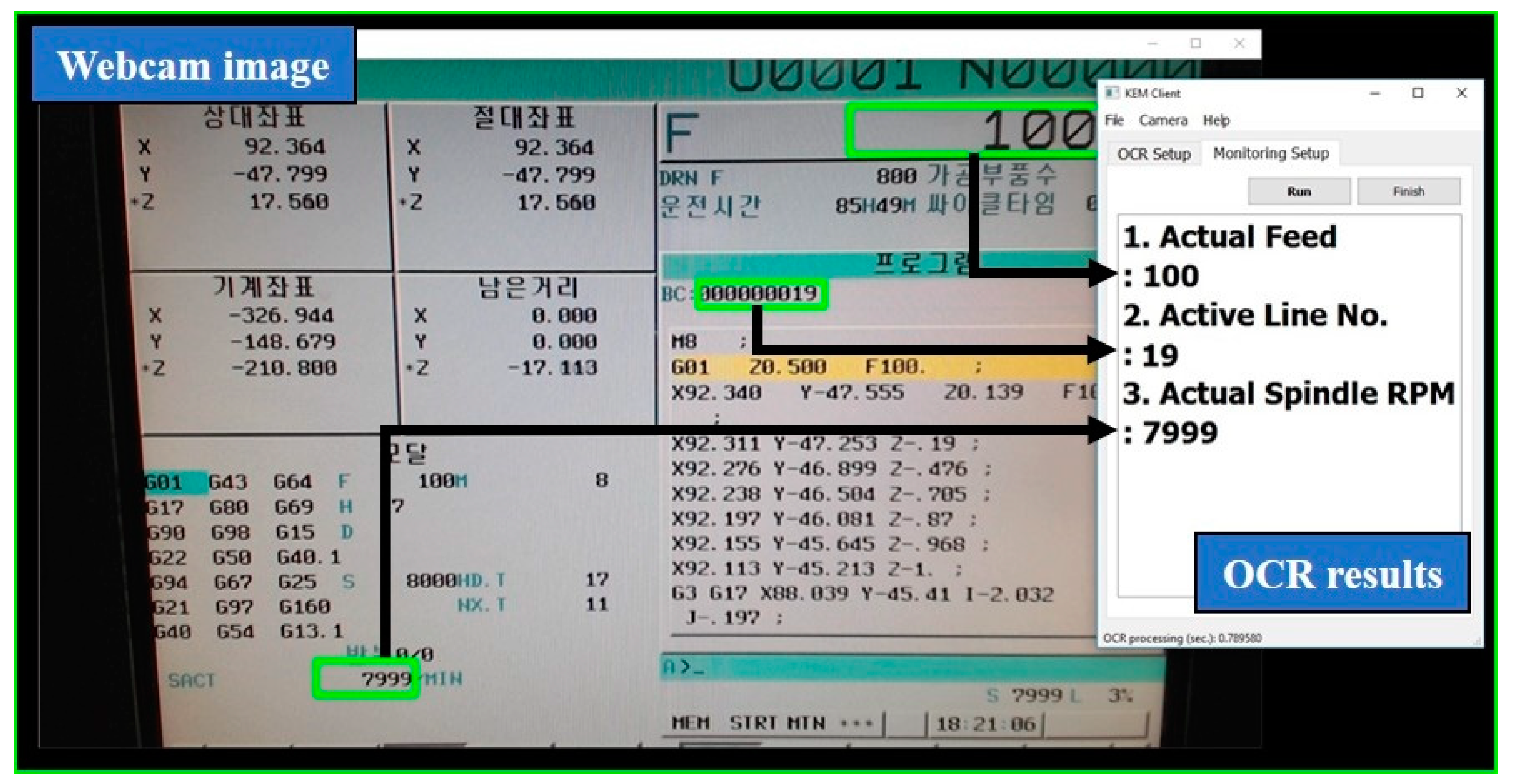
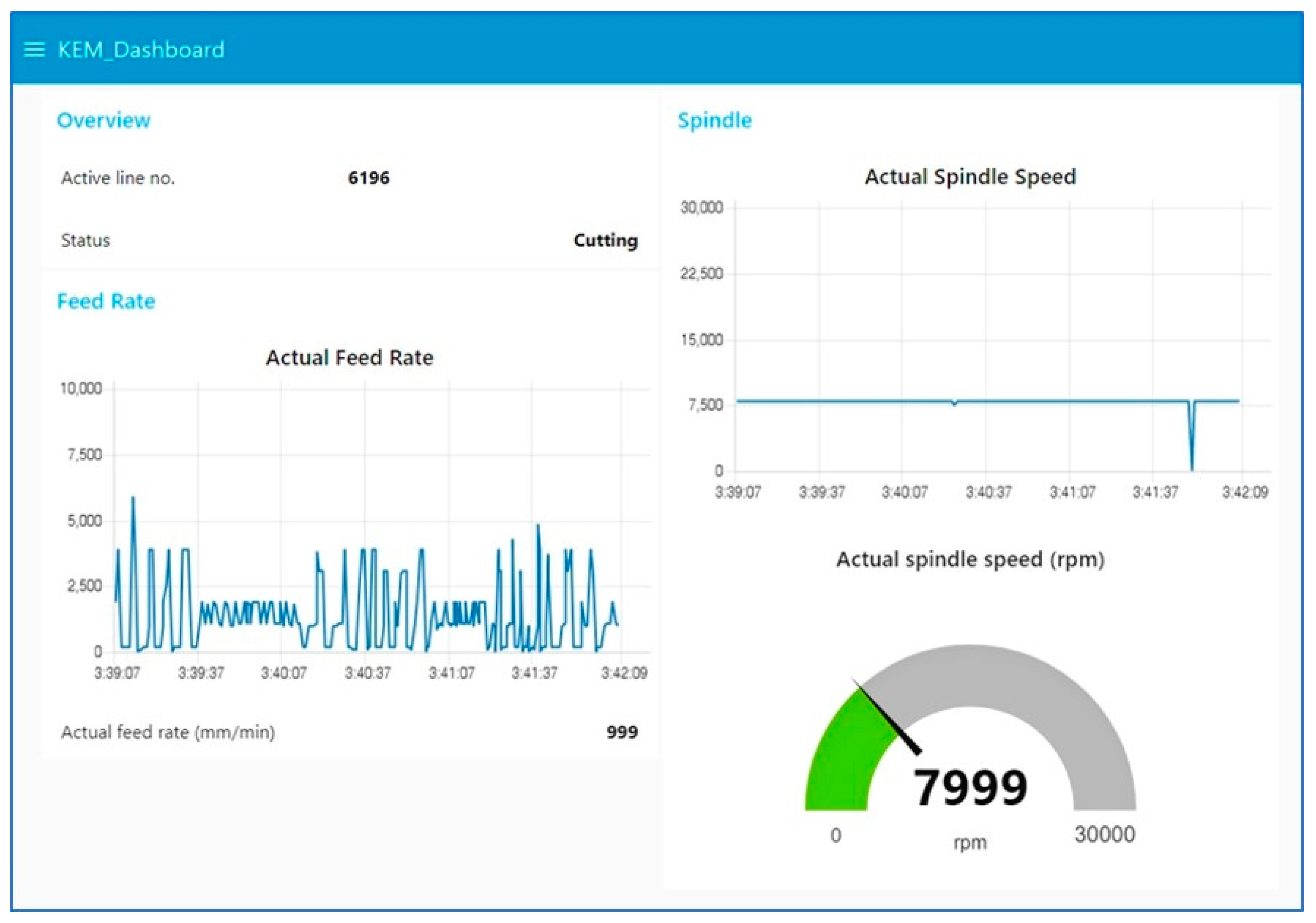
| Topic | SME | Large Enterprise |
|---|---|---|
| Employees | Less than 250 | 250 or more |
| Business strategy | Market niches | Large market share |
| Production | Simple and flexible, labor-intensive with limited resources | Complex and rigid, capital intensive |
| R&D | Short-term and intuitive, lack of expertise, especially IT staff | Long-term and planned, a high number of researchers and experts |
| Procurement | Highly depends on external orders | Mostly independent from external orders |
| Model | C920r |
|---|---|
| Manufacturer | Logitech |
| Sensor type | CMOS |
| Resolution (pixels) | 1920 × 1080 |
| Frame rate (frames per second, fps) | 30 |
| Information in HMI Screen | Acquirable Operation Data | Acquirable Operation Status |
|---|---|---|
| G&M Codes | Current line number, modal (m code) value | Program progress, cycle start and finish, takt time and elapsed time in machining, coolant use (on/off) |
| Spindle Speed | Values of program, actual, override | Spindle start and stop, in-cutting, machine idle |
| Feed Rate | Values of program, actual, override | Machine idle |
| Cutting Tool | Active tool number | (n/a) |
| Spindle load (optional) | Cutting load value | In-cutting |
| Alarm code (optional) | Error messages or codes | Reason of alarm (failure) in machining |
| Operational Status | Reasoning Logic | Expected Additional Information |
|---|---|---|
| Cycle start | Line number changes from 0 to 1 or higher | Time of cycle start |
| Spindle Start | Actual spindle speed changes from 0 to higher | Working in cutting status |
| Cutting | Actual feed rate > 0 and spindle speed > 0 | Machine-in-use |
| Spindle Stop | Actual spindle speed change from any to 0 | Working in non-cutting status |
| Cycle finish | M30 or M02 | Time of cycle finish and no. of machined parts |
| Machine idle | Spindle speed is 0, feed rate is 0, and keep these conditions more than 5 s | Reducing energy consumption |
| Alarm | Refer a list of alarm code | Maintenance issue |
| Takt time | Cycle finish time—cycle start time | Productivity |
| Elapsed time | Current time—cycle start time | Energy consumption |
| Coolant use | Time of coolant on | Monitoring and reducing environmental impact |
| Item/Tool | Product/Service | Cost (USD) |
|---|---|---|
| Webcam | Logitech C920r 1 | $99 |
| Client computer | LattePanda (4G/64G, Windows 10 IoT Enterprise) 1 | $209 |
| Hub computer | Raspberry Pi 3 Model B+ 1 | $35 |
| Python IDE | Microsoft Visual Studio Code 2 and Python IDLE (v3.6.4) 3 | $0 |
| GUI design | Qt Creator and PyQt 3 | $0 |
| OCR | Tesseract (v3.5.1) 3 and tesserocr (v2.2.2, python wrapper package) 3 | $0 |
| Image processing | OpenCV 3 | $0 |
| Data platform | Mobius IoT platform (v2.0) 3 | $0 |
| Web chart | Node-RED Dashboard 3 | $0 |
| Communication protocol | MQTT 3 and onoM2M 3 | $0 |
| Wireless network | Wi-Fi (hardware supported, Raspberry Pi and LattePanda) | $0 |
| Cable, etc. | Power connector, holding device, and so on | $50 |
| (Total sum) | $393 |
© 2019 by the authors. Licensee MDPI, Basel, Switzerland. This article is an open access article distributed under the terms and conditions of the Creative Commons Attribution (CC BY) license (http://creativecommons.org/licenses/by/4.0/).
Share and Cite
Kim, H.; Jung, W.-K.; Choi, I.-G.; Ahn, S.-H. A Low-Cost Vision-Based Monitoring of Computer Numerical Control (CNC) Machine Tools for Small and Medium-Sized Enterprises (SMEs). Sensors 2019, 19, 4506. https://doi.org/10.3390/s19204506
Kim H, Jung W-K, Choi I-G, Ahn S-H. A Low-Cost Vision-Based Monitoring of Computer Numerical Control (CNC) Machine Tools for Small and Medium-Sized Enterprises (SMEs). Sensors. 2019; 19(20):4506. https://doi.org/10.3390/s19204506
Chicago/Turabian StyleKim, Hyungjung, Woo-Kyun Jung, In-Gyu Choi, and Sung-Hoon Ahn. 2019. "A Low-Cost Vision-Based Monitoring of Computer Numerical Control (CNC) Machine Tools for Small and Medium-Sized Enterprises (SMEs)" Sensors 19, no. 20: 4506. https://doi.org/10.3390/s19204506
APA StyleKim, H., Jung, W.-K., Choi, I.-G., & Ahn, S.-H. (2019). A Low-Cost Vision-Based Monitoring of Computer Numerical Control (CNC) Machine Tools for Small and Medium-Sized Enterprises (SMEs). Sensors, 19(20), 4506. https://doi.org/10.3390/s19204506







